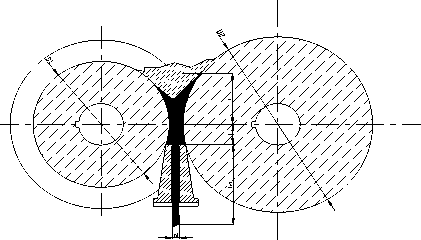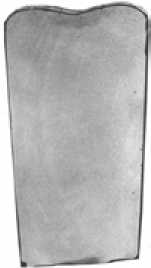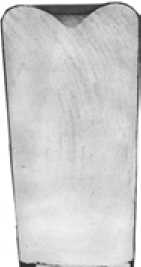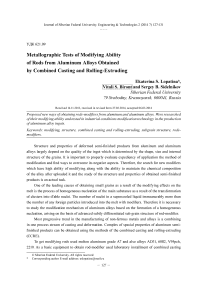Metallographic tests of modifying ability of rods from aluminum alloys obtained by combined casting and rolling-extruding
Автор: Lopatina Ekaterina S., Biront Vitali S., Sidelnikov Sergey B.
Журнал: Журнал Сибирского федерального университета. Серия: Техника и технологии @technologies-sfu
Статья в выпуске: 2 т.7, 2014 года.
Бесплатный доступ
Proposed new ways of obtaining rods-modifiers from aluminum and aluminum alloys. Were researched of their modifying ability and tested in industrial conditions modification technology in the production of aluminum alloy ingots.
Modifying, structure, combined casting and rolling-extruding, subgrain structure, rodsmodifi ers
Короткий адрес: https://sciup.org/146114826
IDR: 146114826 | УДК: 621.09
Текст научной статьи Metallographic tests of modifying ability of rods from aluminum alloys obtained by combined casting and rolling-extruding
Structure and properties of deformed semi-finished products from aluminum and aluminum alloys largely depend on the quality of the ingot which is determined by the shape, size and internal structure of the grains. It is important to properly evaluate expediency of application the method of modification and find ways to overcome its negative aspects. Therefore, the search for new modifiers which have high ability of modifying along with the ability to maintain the chemical composition of the alloy after uploaded it and the study of the structure and properties of obtained semi-finished products is an actual task.
One of the leading causes of obtaining small grains as a result of the modifying effects on the melt is the process of homogeneous nucleation of the main substance as a result of the transformation of clusters into sTable nuclei. The number of nuclei in a supercooled liquid immeasurably more than the number of any foreign particles introduced into the melt with modifiers. Therefore it is necessary to study the modification mechanism of aluminum alloys based on the formation of a homogeneous nucleation, arising on the basis of advanced subtly differentiated sub grain structure of rod-modifier.
Most progressive trend in the manufacturing of non-ferrous metals and alloys is a combining in one process stream of casting and deformation. Complex of special properties of aluminum semifinished products can be obtained using the methods of the combined casting and rolling-extruding (CCRE).
To get modifying rods used molten aluminum grade A7 and also alloys AD31, 6082, V95pch, 2219. As a basic equipment to obtain rod-modifier used laboratory installment of combined casting

Fig. 1 Scheme of metal movement by the method CCRE and rolling-extruding created on the basis of technical solution protected by patent RF №2200644. The metal is heated in an electric furnace to a temperature of 720 °С, obtained melt and pour it directly into the caliber of rolls (Fig. 1). After the capture by the rolls of crystallized in the form of a rectangular billet metal compressed by rolls and reached the matrix under the influence of the supplied by rolls friction stresses extruded as rod of given diameter through caliber hole of the matrix. To prevent the penetration of the metal into the gap between the rolls and the matrix, the last with a special wedge device was tight compressed to the rolls and overlap caliber downstream of the rolls.
This technology provides the most favorable conditions of high speed crystallization-deformation of the metal and obtaining rod which has sustained petty subgrain structure. Stability of rod’s subgrain structure related to the onset of recrystallization temperature. The experimental results showed that temperature of the beginning and end of recrystallization for rods from aluminum grade А7 obtained with using method CCRE are equal Т Р Н = 290 °С, Т Р К = 350 °С. This is on 40-70 °С more than the recrystallization temperature of aluminum rod produced by traditional technology of bar rolling, that is indicating a more sTable subgrain structure of rod obtained with using method CCRE.
Were established the optimal technological parameters of modification aluminum alloys by aluminum rod obtained with using method CCRE. The study of these parameters was conducted using method Alkane-test. Maximum modification effect is achieved by introduction in liquid aluminum 3-4 % (Table 1) rod-modifier diameter 5-9 mm (Table 2), and the temperature of molten aluminum at the moment of modification should be in the range 700-720 °С.
To obtain a homogeneous fine grained structure throughout section of the ingot necessary maintaining a minimum of 5 minutes and thorough mixing of the melt (Fig. 2) after the introduction of the modifying material.
Were carried out experiments on the modification of aluminum alloys АD31 and 6082 by rods from alloys of the same composition obtained with using method CCRE. Analysis of the macrostructure Alkane-test probe showed that in the initial state the number of grains in an area of 1 cm 2 is 5-15 pcs. After the introduction of modifying additive (2,5 % per 1 kg of melt) in the samples there is a significant grain refinement to 1200-2000 pcs/cm2 which proves the possibility of use as a modifying additive to grind grain in ingots of aluminum and its alloys rods of technical aluminum grade А7 and rods of alloys АД31 and 6082 produced by method of casting and rolling-extruding.
Also studied modifying possibility of rods under industrial conditions of production serial of ingots from different aluminum alloys such as В95пч, 2219 and AD31.
Table 1. The influence of modifier amount on grain refinement of aluminum ingots grade A7 based on the results macro-analysis
|
№ p/p |
modifier amount (% by mass) |
Number of grains per 1 cm2 after 1 min |
Number of grains per 1 cm2 after5 min |
The average grain size after 5 minutes, um |
|
1 |
1 |
55 |
70 |
1450 |
|
2 |
2 |
650 |
750 |
425 |
|
3 |
3 |
1900 |
2000 |
225 |
|
4 |
4 |
1400 |
1600 |
255 |
|
5 |
5 |
700 |
800 |
360 |
|
Note: The original grain size is 4.0 microns |
||||
Table 2. Number and size of the grains of the modified aluminum grade A7 based on the results microanalysis
|
№ p/p |
Rod diameter, mm |
Temperature parameters, °С |
Number of grains in 1 cm2, pcs |
The average grain size, um |
|
1 |
3 |
Т Н – 720; Т К – 675 |
1700-1800 |
267 |
|
2 |
5 |
Т Н – 700; Т К – 690 |
11500-12500 |
98 |
|
3 |
7 |
Т Н – 700; Т К – 690 |
11000-12000 |
109 |
|
4 |
7 |
Т Н -700; Т К – 650 |
11200-12000 |
105 |
|
5 |
7 |
Т Н – 720; Т К -650 |
11500-12500 |
100 |
|
6 |
9 |
Т Н -720; Т К – 650 |
11200-12000 |
105 |
|
Note: Т Н – temperature of molten aluminum with the introduction of the modifying rod, Т К – casting temperature of probe Alkane-test. |
||||

a
b
c
Fig. 2 Macrostructure of Alkane-test probes from aluminum А7 (× 1,1), modifiable by rod diameter 9 mm from А7: a – original aluminum А7; b – sampling in 1 minute after injection of rod, without mixing; c – sampling in 5 minutes after injection of rod, with mixing
To estimate modifying ability of rods from aluminum А7 obtained with using method CCRE and compare their effectiveness with the applicable on Verhnyaya Salda Metallurgical Production Association (VSMPA) modifiers there have been several versions of melts and obtained experimental ingots from alloys В95пч and 2219.
Table 4. Quantitative parameters of the structure experimental ingots of alloy AD31
|
State of the sample |
Diameter of ingot, mm |
Grain size, um |
Number of grains in 1 cm 2 |
|
without addition of rod |
110 |
192,9 |
2687,0 |
|
with addition of rod diameter 9 mm from alloy А7 |
110 |
147,8 |
4576,9 |
|
without addition of rod |
192 |
212,1 |
2222,4 |
|
with addition of rod diameter 9 mm from alloy А7 |
192 |
197,2 |
2571,9 |

Fig. 3 Macrostructure of ingots diameter 52 mm from alloy В95пч (a, b) and alloy 2219 (c, d): a – modified by А7 and Al-Ti -В; b, d – modified by А7; c – modified by Al-Ti – В


d
Macrostructure study showed that the introduction of into the alloy В95пч new modifying material in the form of rod from А7 jointly with ligature Al-Ti-B and without this ligature has provided reasonable homogeneous, dense, fine grained equiaxed structure (Fig. 3 a, b). Macrostructure of the alloy 2219 modified by rod А7 (Fig. 3 d) has a similar fine grain structure; it can be concluded about perspective of the new modifier material during casting of industrial ingots from different aluminum alloys.
Have been conducted studies of rod modifying ability obtained with using method CCRE during casting ingots diameter 110 mm and 192 mm from alloy АD31. Quantitative parameters of the structure experimental ingots of alloy AD31 determined by the results of microstructural analysis (Table 4).
Thus, the study of the processes of a homogeneous modification and implementation of this process with the use of materials obtained by the method of high speed crystallization-deformation provide an opportunity to improve the quality of aluminum ingots by grinding their grain structure without contaminating the chemical composition by the substance of modifier. Technology of combined casting and rolling-extruding allow obtaining rods-modifiers with subgrain subtly differentiated structure required for effective modification of ingots. Established optimal ratio of technological parameters of production modifying rods and technology of modifying ingots with their use based on which provides methods for producing high-quality ingots.
Testing of modification technology in obtaining industrial ingots in Verhnyaya Salda Metallurgical Production Association showed that the modification by rod from aluminum obtained with using method CCRE results in the homogeneous grain structure of ingots from aluminum alloys. Consequently, these rods can be used as modifiers under industrial conditions.
Металлографические исследования модифицирующей способности прутков из алюминиевых сплавов, полученных методом совмещенного литья и прокатки-прессования
Е.С. Лопатина,I В.С. Биронт] , С.Б. Сидельников
Сибирский федеральный университетРоссия, 660041, Красноярск, пр. Свободный, 79
Предложены новые способы получения прутков-модификаторов из алюминия и алюминиевых сплавов. Была изучена их модифицирующая способность и опробована в промышленных условиях технология модифицирования при производстве слитков из алюминиевых сплавов.


